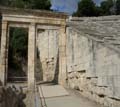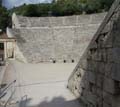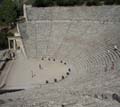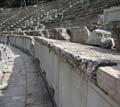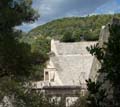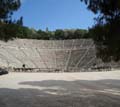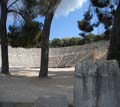
The Theater of Asclepius of Epidaurus was built on the western side of Mount Kynorti, at the end of the Classical era, around 340-330 BC, as part of the general reconstruction of the sanctuary and was used at least until the 3rd century. A.D. This unique monument, the most perfect and famous ancient Greek Theatre, which combines elegance with perfect acoustics, is according to Pausanias, the work of Polykleitos (the Younger), the creator of the Dome in the same sanctuary.
The monument was built to host the musical, odic and dramatic competitions of the Asclepians. Drama performances were also given there, which were included in the cult of Asclepius. In the middle of the 2nd c. BC, its hollow was expanded and its capacity from about 8,000 increased to 13,000-14,000 spectators. At the same time, the stage building was shaped so that the actors played exclusively in the logeum, i.e. on the platform above the stage, and no longer in front of it. During the Roman Empire, it maintained the characteristics of the Greek Theater, even after its repair from the damage it suffered during the invasion of the Heruli in 267 BC, mainly in the stage building.
The hollow of the Theater has been built on the hillside with limestone material while its parapets are made of pumice stone. A paved passage, 1.90 m wide, separates the part of the hollow that was built first, from a newer part, the epitheatre. Thirteen radial staircases lead to the 34 rows of twelve equal stands of the original section, while the amphitheater consists of 22 stands and 23 staircases leading to 21 rows of seats. The first and last rows of the original segment as well as the first row of the new one have seats with backrests. The hollow was surrounded by a corridor and a porous protective wall. Monumental two-door gates were built in the passages, from which inclined levels (platforms) led to the foreground.
The stage building built with ashlars came to light in ruins. It consists of the foreground and a two-story stage, framed by backdrops. Originally it had two colonnades with pediments, one on the front of the proscenium, decorated with Ionic semi-columns, and the other on the back side of the ground-floor stage hall. In the middle of the 2nd c. BC this side was closed, while on the contrary, five accesses to the lecture hall were opened on the front of the tent floor. The movable paintings were then moved from the foreground to the floor, which were placed between pesses to shape the scenery according to the drama being performed. The scenic building was also decorated with sculptures, of which little survived.
The harmony of this Theater is due to its unique design based on a regular pentagon, in which the orchestra is inscribed, as well as the use of three centers to outline the curved rows of the hollow seats. The acoustics of this Theater are also famous.
The monument was brought to light by the excavations of P. Kavadias in the years 1881-83. Initially in 1907, but also during the period 1954-1963, restoration work was carried out on the doors of the passages, on the retaining walls and on the extreme bleachers of the original part of the hollow.
Since 1988, the maintenance of the Theater has been undertaken by the Epidaurus Monuments Preservation Committee, initially restoring the extreme western bleachers of the theater, the door of the western passage and the two storm drains of the orchestra. The care of the monument is continuous and aims to restore the damages suffered by the monument from natural causes as well as from its use.
Since 1954, ancient drama performances have been held in their natural space every summer.
Editor Epidaurus Monuments Preservation Committee












